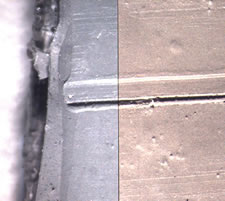- 01: Introduction
- 02: History
- 03: Propellants, Firearms, and Ammunition Development
- 04: Modern Firearms Manufacture
- 05: Small Arms Ammunition
- 06: Evidence Handling Procedures
- 07: Equipment and Instrumentation
- 08: Examination of Firearms
- 09: Cartridge and Shotshell Examination
- 10: Characterization and Evaluation of Fired Projectiles
- 11: Bullet Comparison and Identification
- 12: Gunshot Residue and Distance Determination
- 13: Toolmark Identification
- 14: Communicating Results
- Resources


Casting
Home > Bullet Comparison and Identification > Casting
Bullet Surface Replication

Bullet casts in Mikrosil™
Occasionally, it may be necessary to physically compare bullets when one of the bullets is not available to the examiner.
This situation can arise due to
- NIBIN-related high-probability associations (hits) made in a remote laboratory that must be physically examined using a comparison microscope,
- routine liaison with examiners from other jurisdictions concerning possibly related cases,
- information provided to investigators by an informant indicating possible case linkages between cases from different jurisdictions.
However, there may be administrative obstacles that can prevent or delay the physical comparison, such as
- chain of custody concerns (integrity of evidence) on the part of investigative agencies and prosecutor’s offices,
- policies relating to the shipment or transport of evidence to other laboratories or jurisdictions,
- budgetary constraints regarding long distance travel to other jurisdictions.
The most practical and expeditious solution in these circumstances may be to use casting materials to replicate the microscopic surface of a fired bullet. The cast is then shipped to the examiner who will perform the comparison. This casting approach is recognized in the AFTE Procedural Manual. It is an extension of the rationale used in casting of other types of toolmarks.
It is important to bear in mind that a cast must be compared with another cast, not with the casted bullet itself; a cast is the reversal of the bullet surface.




